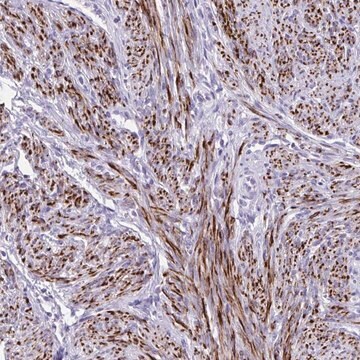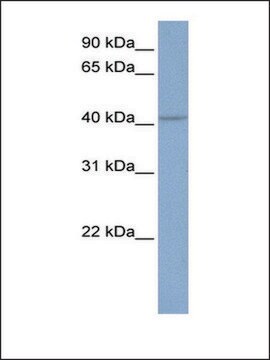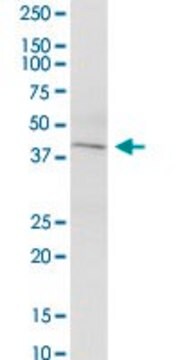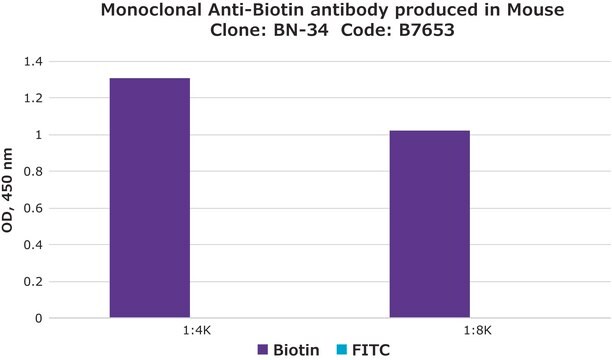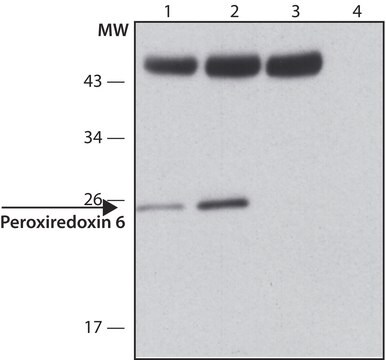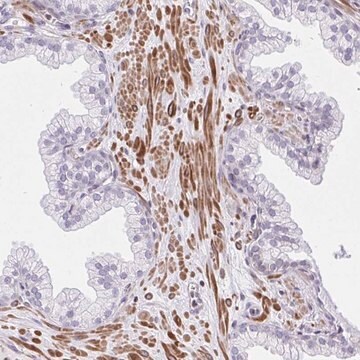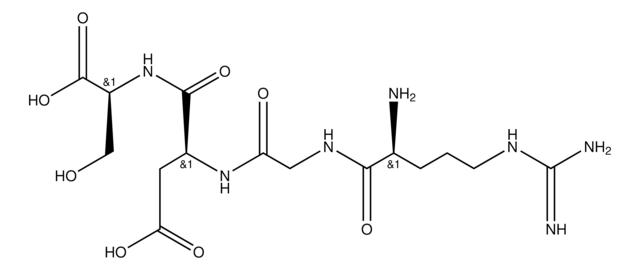AB5719
Przeciwciało anty-KCa3.1
Chemicon®, from rabbit
Synonim(y):
Intermediate conductance Ca2+-activated K+ Channel 4, SK4, IKCa1, KCNN4
About This Item
Polecane produkty
pochodzenie biologiczne
rabbit
Poziom jakości
forma przeciwciała
affinity purified immunoglobulin
rodzaj przeciwciała
primary antibodies
klon
polyclonal
oczyszczone przez
affinity chromatography
reaktywność gatunkowa
human, mouse
producent / nazwa handlowa
Chemicon®
metody
western blot: suitable
numer dostępu NCBI
numer dostępu UniProt
Warunki transportu
wet ice
docelowa modyfikacja potranslacyjna
unmodified
informacje o genach
human ... KCNN4(3783)
Specyficzność
Immunogen
Zastosowanie
Rozcieńczenia należy wykonywać przy użyciu białka nośnikowego, takiego jak BSA (1-3%)
Optymalne rozcieńczenia robocze muszą być określone przez użytkownika końcowego.
SUGEROWANY PROTOKÓŁ WESTERN BLOT
1. Wymieszać próbki (błony narządów: 50 μg/pas; transfekowane komórki: 500 000 komórek/pas) z buforem do próbek X 2 i ogrzewać przez 10 minut w temperaturze 70°C.
2. 5-50 μL nanieść na pas Minigel (szerokość 0,75-1,5 mm) i przeprowadzić w standardowych warunkach. (60 mA dla 2 żeli Minigel 1,5 mm, 1,4 h). Sugeruje się, aby uruchomić 5-15% akryloamid (37,5:1 akryloamid:bisakryloamid) minigel (szerokość 1,5 mm) przy 30 mA/żel ~1-1,5 godziny.
3. Transfer w systemie półsuchym w standardowych warunkach (3 h 100 mA dla dwóch żeli minigel).
4. Wybarwić przeniesione pasma za pomocą Chemicon BLOT-FastStain (numer katalogowy 2076).
5. Odbarwić za pomocą wody dejonizowanej. 6. Zablokować za pomocą 5% beztłuszczowego mleka (Marvel lub Carnation) w PBS i 0,025% azydku sodu, przez noc w temperaturze 2-8°C. Mleko beztłuszczowe powinno być świeżo rozpuszczone, odwirowane z prędkością 10 000 obrotów na minutę przez 10 minut i przefiltrowane przez filtr szklany (Gelman Acrodisc). 7.
7. Inkubacja z pierwszym przeciwciałem przez 2 godziny w temperaturze pokojowej lub przez noc w temperaturze 4°C w roztworze blokującym. Preparat przeciwciała należy odwirować przed użyciem (10 000 g 5 min.). Optymalne rozcieńczenia robocze i czas inkubacji muszą zostać określone przez użytkownika końcowego.
8. Płukać 4 x 10 min. za pomocą PBS-0,1% tween 20. Na tym etapie należy pominąć azydek.
9. Inkubacja z przeciwciałem drugorzędowym (kozie przeciwciało przeciwkrólicze sprzężone z HRP, na przykład Chemicon nr katalogowy AP132P, odpowiednio rozcieńczone) przez 1 godzinę w temperaturze pokojowej.
10. Płukać 4 x 10 min. za pomocą PBS-0,1% tween 20.
11. Wykonać ECL przy użyciu komercyjnych zestawów (Chemilucent, numer katalogowy Chemicon 2600).
Neuroscience
Ion Channels & Transporters
Postać fizyczna
Przechowywanie i stabilność
Komentarz do analizy
Do przeciwciała dołączono bezpłatnie 40 μg antygenu kontrolnego. Roztwór podstawowy antygenu można sporządzić przy użyciu 100 μl sterylnej wody destylowanej. W przypadku kontroli negatywnej należy wstępnie inkubować 2 μg peptydu z 1 μg przeciwciała przez godzinę w temperaturze pokojowej. Optymalne stężenia muszą zostać określone przez użytkownika końcowego.
Inne uwagi
Informacje prawne
Oświadczenie o zrzeczeniu się odpowiedzialności
Nie możesz znaleźć właściwego produktu?
Wypróbuj nasz Narzędzie selektora produktów.
Zwroty wskazujące rodzaj zagrożenia
Zwroty wskazujące środki ostrożności
Klasyfikacja zagrożeń
Aquatic Chronic 3
Kod klasy składowania
11 - Combustible Solids
Klasa zagrożenia wodnego (WGK)
WGK 3
Certyfikaty analizy (CoA)
Poszukaj Certyfikaty analizy (CoA), wpisując numer partii/serii produktów. Numery serii i partii można znaleźć na etykiecie produktu po słowach „seria” lub „partia”.
Masz już ten produkt?
Dokumenty związane z niedawno zakupionymi produktami zostały zamieszczone w Bibliotece dokumentów.
Nasz zespół naukowców ma doświadczenie we wszystkich obszarach badań, w tym w naukach przyrodniczych, materiałoznawstwie, syntezie chemicznej, chromatografii, analityce i wielu innych dziedzinach.
Skontaktuj się z zespołem ds. pomocy technicznej